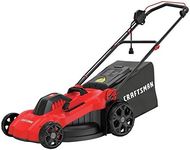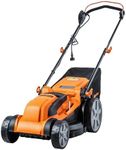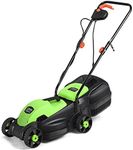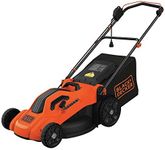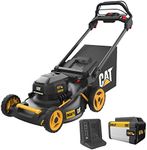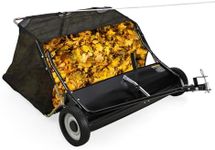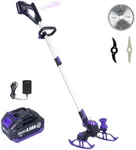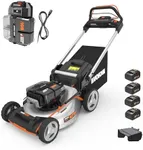Buying Guide for the Best Corded Electric Lawn Mower
Choosing the right corded electric lawn mower can make your lawn care routine much easier and more efficient. These mowers are known for their consistent power supply and eco-friendliness, as they don't produce emissions like gas-powered mowers. When selecting a corded electric lawn mower, it's important to consider several key specifications to ensure you get the best fit for your lawn size, terrain, and personal preferences.Cutting WidthThe cutting width refers to the width of the mower's blade and determines how much grass the mower can cut in a single pass. This spec is important because it affects how quickly you can mow your lawn. Cutting widths typically range from 14 inches to 21 inches. For small to medium-sized lawns, a cutting width of 14-16 inches is usually sufficient. For larger lawns, a cutting width of 18-21 inches will help you finish the job faster. Choose a cutting width based on the size of your lawn and how much time you want to spend mowing.
Motor PowerMotor power, measured in amps, indicates the strength of the mower's engine. This spec is crucial because it affects the mower's ability to cut through thick or tall grass. Motor power for corded electric lawn mowers typically ranges from 10 to 15 amps. For regular lawn maintenance with average grass height, a motor power of 10-12 amps is usually adequate. If you have thicker or taller grass, or if you often let your lawn grow longer between mowings, consider a mower with 13-15 amps for better performance. Choose motor power based on the type of grass and the frequency of your mowing routine.
Cutting Height AdjustmentCutting height adjustment allows you to change the height at which the mower cuts the grass. This spec is important for maintaining the health of your lawn, as different grass types and seasons may require different cutting heights. Most mowers offer a range of cutting heights, typically from 1 to 4 inches. Look for a mower with easy-to-use height adjustment settings, ideally with a single lever. Choose a mower with a range of cutting heights that suits the type of grass you have and the look you want for your lawn.
Cord LengthCord length refers to the length of the power cord that comes with the mower. This spec is important because it determines how far you can mow from an electrical outlet without needing an extension cord. Cord lengths typically range from 50 to 100 feet. For small to medium-sized lawns, a 50-foot cord may be sufficient. For larger lawns, you may need a 100-foot cord or an appropriate extension cord. Choose a cord length based on the size of your lawn and the distance to the nearest power outlet.
WeightThe weight of the lawn mower affects how easy it is to maneuver and transport. This spec is important for user comfort, especially if you have a larger lawn or need to carry the mower up and down stairs. Corded electric lawn mowers typically weigh between 30 to 60 pounds. For ease of use, especially on uneven terrain or if you have physical limitations, choose a lighter mower. If you have a flat lawn and don't mind a bit of extra weight, a heavier mower may offer more stability. Choose the weight based on your physical ability and the terrain of your lawn.
Grass Management OptionsGrass management options refer to how the mower handles the grass clippings. Common options include bagging, mulching, and side discharge. This spec is important because it affects the cleanliness and health of your lawn. Bagging collects clippings in a bag for easy disposal, mulching finely chops the clippings and returns them to the lawn as fertilizer, and side discharge ejects clippings to the side. Choose a mower with the grass management option that best fits your lawn care routine. If you prefer a clean lawn, bagging is ideal. If you want to naturally fertilize your lawn, mulching is a good choice. Side discharge is useful for quickly mowing large areas.
